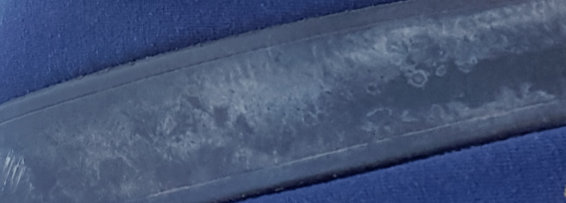WHAT DAMAGES LEATHER?
Both moisture and dryness damage leather. This might seem strange until you consider what keeps leather pliable and resilient: oil. Tanned leather contains oils (both natural and additives) that allow it to flex without cracking. When water is allowed to penetrate the leather, it can wash out these oils. Over time, the repeated cycle of getting wet and having the water evaporate off can leave the leather brittle and dry. This in turn leads to cracking and eventually total failure as the fibers breakdown (also known as dry rot.) If you add in the heat that is trapped under your gear and the salt from your sweat, the effect is accelerated. All leather will fail this way if not cared for.

WHAT DO WE DO TO PREVENT DAMAGE?
The equipment we make has some built in protections against losing its oils. First, we only use top quality, full-grain leather. Cheaper grades of leather or leather that has been sanded down for cosmetic reasons loses its oils faster. Before the tanned hides are even shipped to us, they are treated with natural greases, oils, and tallow that is pressed deep into the leather. This process is known as “hot-stuffing”. It is a time consuming (and therefore expensive) process for the tannery to do but it gives you a very durable, pliable, and long lasting piece of leather from the start. After it gets to us, we do a few things that help build on this foundation. All edges are burnished and treated with bee’s wax. This helps seal the edge fibers from exposure to the elements. Next, we treat the leather with an additional conditioner. Lastly, we use a different type of wax to treat both the front (the grain side) and the back (the flesh side.) These combined treatments give the item very solid resistance to moisture and dryness. That said, even the best quality, most thoroughly treated piece of leather will eventually become damaged if neglected.

WHAT CAN I DO TO PREVENT DAMAGE?
Some very basic maintenance every few months will keep your leather in top condition. Here’s a few indicators that its time to clean and condition your leather:
- Does it feel rough or dry to the touch? The grain of the leather should feel smooth and slick.
- Does it have sweat stains on it? The flesh side is especially vulnerable to salts from your skin.
- Is it excessively dirty? Some grime is to be expected but excessive amounts require cleaning.

WHAT DO WE RECOMMEND FOR KEEPING EVERYTHING IN GOOD CONDITION?
- We recommend rubbing the leather with a bee’s wax and tallow/natural oil based conditioner every 6 months or so. If the leather has really taken a beating, you may want to apply some sooner. We recommend Obenauf’s Heavy Duty LP or Skidmore’s Leather Cream but there are many that will do a good job. No need to go overboard, a small tub will last you practically forever.
- Quality conditioners are easily applied: put a thin coat on the leather and let it soak in. After about 30 minutes or more, just buff off the excess.
That’s it. Leather care is not complicated or time consuming, you merely need to look it over periodically, condition it every now and then, and keep it free of excess dirt and contaminates. If you take these simple steps, your leather will last your career and beyond. As always, if you have any questions or concerns about maintenance or leather care products, just contact us and we’ll assist you.
